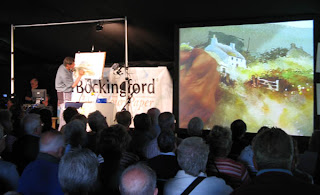Taking time to consider your composition before you begin painting is critical, and unless you are working from a sketch with a fairly well-planned composition it’s worth doing one or two studio sketches to plan the overall design. While we may feel that composition is solely concerned with the positioning of the various elements of a scene, we also need to think about the atmosphere and lighting conditions, and how this will affect the finished result.

In this watercolour of Ravenglass in Cumbria I have kept the horizon line below the halfway mark and the focal point – the cottages – approximately one third from the bottom and one third from the left-hand side in the classic golden rule of thirds. There are times, however when you may wish to ignore this rule, so don’t feel you are bound to it. Happily in watercolour you can always cut a bit off the side, top or bottom if you want to adjust matters! While most of the detail is around the cottages I placed a boat over on the right-hand side to balance things out: it doesn’t compete with the focal point but helps the overall design. Note that the boat is happily looking into the composition. It was in fact sulking a long way off to the right.
The streaks of water in the foreground were all over the place, so I changed them to use as a lead in to the focal point. Closer to the left-hand edge I have washed a dull shadow over the buildings, as it is best not to introduce strong detail or contrasts at the very edge. Between the posts to the right of the cottages you can see two figures, although these might well be mistaken for giant sticks of rhubarb as I haven’t given them much shape, Figures and animals of course draw the eye and it’s helpful to position them near the main detail. Finally we come to the format. I wanted to suggest a tranquil, early evening mood, so I opted for a rectangular layout emphasising the horizontals in the sea, the cloud formation and the ground detail, with the distant land lost in the haze by laying a glaze over it. It was painted on Saunders Waterford rough 140lb paper using Daniel Smith extra-fine watercolours.
Just to remind you that I shall be demonstrating how to use Daniel Smith watercolour sticks sticks at Erwood Station Gallery & Craft Centre on Friday 7th June when I will be signing copies of my new book David Bellamy’s Complete Guide to Landscapes. Action starts at 2pm and I will be there till 4pm so do come along and join in the fun. Erwood Station is a great place to hang out, enjoy a cappuccino and they have the most delicious cakes and pastries! I’ll also have framed and unframed paintings at a discount, but do come and have a look at these magical painting sticks and ask any questions. Erwood Station is about six miles south of Builth Wells, just off the A470 from where it is well signposted. Telephone 01982 560555


 The lay-flat sketchbook is made up of the superb
The lay-flat sketchbook is made up of the superb 